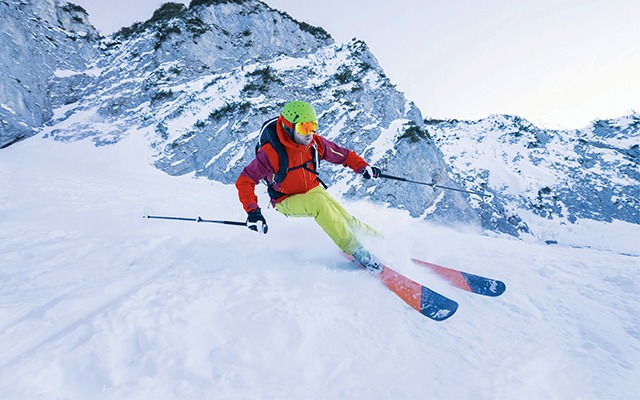Skiing will definitely be a popular activity this winter. Since we all have been spending so much time at home nowadays here are some tips on how to stay safe and performing at your highest this ski season.

Knee injuries are common in skiing. ACL injuries make up 1/3 of all knee injuries that occur on the slopes. Most ACL injuries (over 70%) in skiing occur when the skier is in the “back seat” and catches an inside edge, causing the knee to twist beyond its normal range of motion. It is also important to point out that your non dominant leg has a higher rate of injury then the dominant leg. Females are 2x more likely to injury their non dominant leg. So in order to prevent knee injuries this ski season, it is critical to start preparing your body 6 weeks before hitting the slopes.
A training program with a focus in training the core, gluts, and knees will create a more stable “back seat” ski position on the hills. Body weight exercises like squats and lunges will strengthen the gluts and quadriceps, while planks, crunches, and back extension will focus on the core. Remember keeping an equal balance in strength between both legs is important to prevent injury to the non dominant leg so training each leg in isolation is important. Skiing is mainly an anaerobic exercise meaning your pulse is up to a high level for short burst of time so interval training would mirror this. Some exercises that would be helpful would include mountain climber or burpees.
Falling happens regularly especially when you are learning to ski. Here are some tips on how to fall safely. Remember to keep your knees bent and avoid falling with your knees straight. Also keeps your arms forward and up to avoid falling on your hands. Don’t try to get up until you have stopped sliding. If you are going off a jump, know where you are going to land and keep your knees flexed. Appropriate equipment is critical to being safe. Poorly functioning or improperly adjusted equipment is a frequent cause of injuries. Bindings that are too loose or too tight, as well as equipment that is improperly sized or used on improper terrain, can cause injury. It is also important to listen to your body for signs of fatigue. Most accidents happen on the third day of a ski trip because muscle fatigue has reached its peak 48 hours since the beginning of the trip.
It is important to wear a helmet while on the slopes. Head injuries account for 10-20% of ski and snowboarding injuries. 22% of these are severe enough to cause loss of consciousness and signs of a concussion. Some signs of a concussion include headaches, confusion, loss of memory, fatigue, mood swings. In cases when you suspect someone may have a concussion it is important to direct them medical care as soon as possible. A proper fitting helmet is an important part of staying safe on the hills this season.
Here are a final few common sense precautions.
1) Fresh powdery snow is safer then icy pack down snow.
2) Always stay in control: keep arms forward, keep feet together, hands over skis
3) People ahead of you have the right-of-way
4) Whenever starting downhill or merging, look uphill and yield
5) Finally remember to stay safe and have fun!

